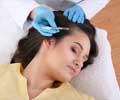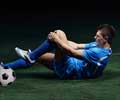Platelet-Rich Plasma therapy is a non -surgical mode of treatment wherein a patient’s own platelets are used to repair tissue damage.
Takashi Saito, of the Los Angeles Dodgers, and approximately 20 other soccer professionals have undergone PRP therapy which, sports medicine experts say, has the potential to successfully treat chronic injuries such as 'tennis elbow' and knee tendonitis.
Platelet-Rich Plasma (PRP) therapy has been a part of surgical applications since the 1970s. Thanks to the recent technological surge, this non-surgical mode of treatment has also forayed into the sports arena too where it is being effectively used to mend ligaments and repair tendon injuries.Tendons are structures that connect muscles to the bone. Any injury or wear and tear of the tendon causes an inflammatory condition called 'tendinosis' which often occurs in the knee, ankle, Achilles tendons, calf, shoulder, biceps and wrist.
Collagen fibers of the ligaments, on the other hand, connect the bones to one another and play a role in controlling movement. A damaged or injured ligament weakens the joint, causes pain and becomes unable to provide the required support.
What is PRP?
Platelet Rich Plasma (PRP) is the name given to blood plasma with a high concentration of platelets (another blood component). These concentrated platelets contain huge doses of bioactive proteins, such as growth factors, that are pivotal in the repair and regeneration of issues. These special proteins also initiate new blood vessel formation, bone regeneration and healing, connective tissue repair and endorse overall wound healing.
The procedure
The core procedure involves collecting a concentrate of Platelets along with White Blood Cells (WBCs) from the patient’s blood, with the aid of a closed platelet separator. This concentrate, which contains platelets and growth factors (multiplied several fold), is then mixed with activating agents and is injected back into the patient’s own damaged tissue where it begins to initiate the process of repair.
The repair response in the injured tissue is kick-started by the formation of a blood clot. This is then followed by the implanted platelets getting dissolved, triggering the release of growth factors which in turn leads to the formation of a fibrous scar tissue . Eventually the injured tissue is completely replaced by healthy cells.
Most people undergoing treatment may require 3-6 doses of injections which is given approximately a month from each other. The risks and side effects do not vary with the number of treatments so a person may have as many as required.
PRP therapy is not a quick fix. Regeneration of injured tendons and liaments will take time. Physical therapy may be continued a week after the procedure.
Procedure Safety
The chances of an adverse reaction is completely nullified because the components used for treatment are derived from a person’s own body. This makes the procedure entirely safe. Besides, the use of closed systems for preparing the PRP concentrate has ruled out any other material entering the system during the production of the concentrate.
A word of Caution
A patient who has undergone PRP therapy may initially suffer some soreness or discomfort, especially at the target site. Some medications like Tylenol may help to control the pain. Heat fomentation or Icepacks may also be applied as required.
The use of Non-Steroidal Anti-Inflammatory medications (NSAIDs) must be stopped one week before the therapy and abandoned throughout the treatment.
Strenuous physical activity is not recommended.
Benefits
Research indicates that the procedure will gain prominence as the first choice of treatment, for reasons both medical and financial. Some of the highlights of PRP are the following:-
• It is a non-surgical option
• It uses the body’s own cells for healing
• It is an option to be considered when there is no immediate cure
• Costs far less ($ 2000) compared to any other surgical procedures
• The entire procedure lasts for not more than twenty minutes
• Short recovery time
• It may reduce or even completely eliminate the need for complicated treatments like, aggressive medications or surgery
Expert Speak
Dr. Allan Mishra, an assistant professor of orthopedics, Stanford University Medical Center who is also a primary researcher in the field, says "I think it’s fair to say that platelet-rich plasma has the potential to revolutionize not just sports medicine but all of orthopedics. It needs a lot more study, but we are obligated to pursue this."
In a 2006 study, Dr. Mishra administered PRP therapy on 15 out of 20 patients who suffered from tennis elbow and who were considering surgical options. The remaining 5 patients were given just an anesthetic. After a lapse of two months, the patients who were administered PRP therapy reported a 60 percent improvement in pain (which was analysed through specific measurements), compared to only 16 percent improvement reported by those who received the anesthetic.
Dr. Mishra said that he was particularly encouraged by the impact of PRP therapy. His study was published in The American Journal of Sports Medicine.
Dr. Gerjo van Osch, who is doing research at the orthopedics department of the Erasmus University Medical Center in the Netherlands said, "This could be a method to stimulate wound healing in areas that are not well-vascularized, like ligaments and tendons."
Ongoing research
Dr. van Osch is currently involved in a randomized, double blind study on the effect of PRP therapy on fifty four patients suffering from Achilles' tendon injuries.
Research is underway in USA, India and Sweden to study the effect of PRP therapy in rotator-cuff shoulder strains, partial knee-ligament tears and bone fractures. Researchers are also evaluating the effectiveness of PRP therapy in combination with surgery as a better treatment option to reduce recovery time.
Being safe and cost-friendly puts PRP therapy high on the list of therapeutics. Nevertheless, there is general consenses that more studies are required to determine its effective use in mainstream treatment.
Source-Medindia
Dr. Reeja Tharu/L











